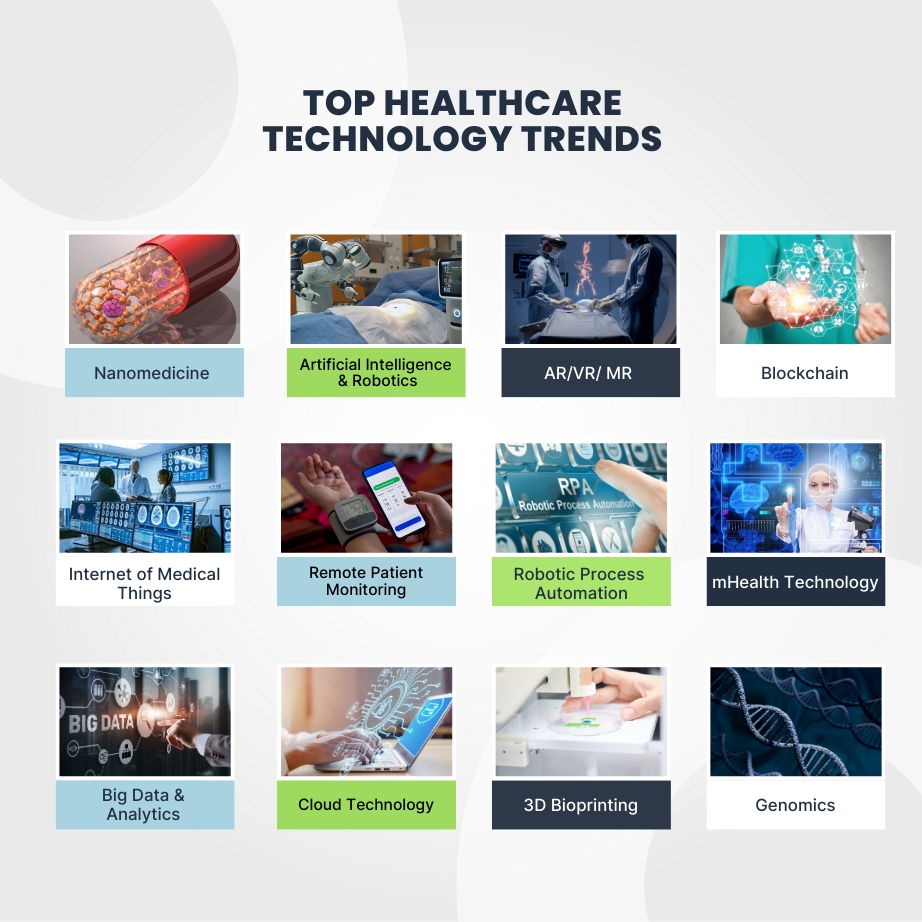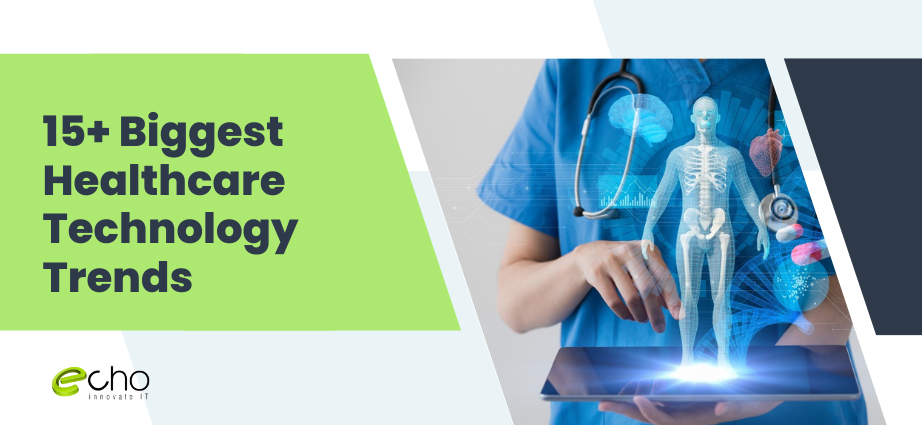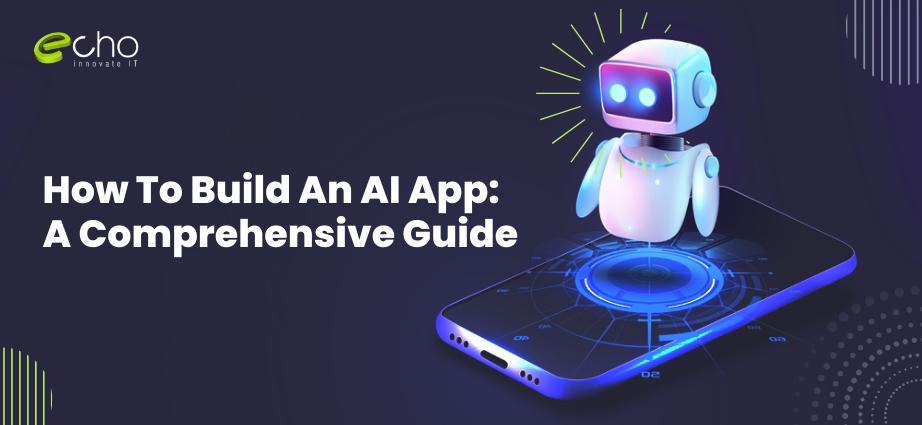Healthcare is constantly evolving, from the widespread adoption of new technologies such as wearable health devices and medical robotics to the ever-changing landscape of regulatory approvals. As a result, healthcare leaders must stay on top of the latest Healthcare Technology Trends in the industry to stay ahead of the competition. By doing so, they can identify what opportunities their organizations need to implement to grow their businesses and improve patient care and employee well-being.
From artificial intelligence to the social determinants of health, we compiled the top healthcare trends that could have a significant impact on the healthcare industry in 2024 and beyond.
Healthcare Market Overview: Striking Statistics You Should Be Aware Of
Check out these latest statistics to learn more in-depth about healthcare technology trends and its current market.
- The global healthcare services market reached nearly $7.5 trillion in 2022-23 and will continue to grow, surpassing $9 trillion by 2026.
- According to the Boston Technology Corporation, 74% of patients say using wearable devices and other mHealth tools helps them cope and manage their conditions.
- As per Statista, the number of connected wearable devices worldwide was 1.1 billion in 2022, and this number has increased substantially and will grow more in the coming years.
- The global healthcare IT market is poised to grow at a CAGR of 13.1% between 2023 and 2030.
- As per the report, the healthcare IT market is projected to reach $857.6 billion by 2030.
Top Healthcare Technology Trends

In the healthcare industry, technology is opening up new possibilities for medical professionals, patients, and treatment recipients. Leading healthcare app development services providers are prioritizing creating solutions that use one of the technologies listed below.
Let’s find out more about the trends that will affect the healthcare industry in the future.
Nanomedicine
This may sound like science fiction, but nanotechnology is slowly entering our daily lives. The application of nanotechnology in medicine is happening as we speak. Self-replicating nanorobots known as Xenobots are being developed by scientists. This may transform nanomedicine.
Science biology grug modifying concept. Laser operation virtual reality research pharmacy. Futuristic medicine research gene therapy health analysis vector illustration. Therefore, it is safe to assume that 2024 may bring a lot of revolutionary news in the field of nanomedicine. The nanomedicine industry welcomes early investors and has enormous potential.
If you are wondering what nanomedicine is, here is a brief definition: it is the use of nanoscale (microscopically tiny) materials and objects, such as biocompatible nanoparticles, nanoelectronic devices, or even nanorobots for specific medical manipulations and purposes, like diagnosing or treating living things.
For example, it can be used as a potential hunter for cancer cells or viruses, requiring a group of nanorobots to be injected into a human’s blood vessels.
This healthcare technology trend is expected to successfully combat many genetic, oncological, or autoimmune diseases at the cellular level, including arthritis, tumors, and others.
Artificial Intelligence & Robotics
In the last decade, the proliferation of AI in all industries has taken the world by storm, and the trend is likely to continue. The application of AI in medicine ranges from increasing diagnostic accuracy to disease detection.
With the pandemic disrupting the healthcare industry, radiologists faced great strain as computerized diagnosis became the norm. In this situation, an AI-based system removed the burden from radiologists by streamlining the diagnostic process.
In a matter of seconds, AI algorithms can perform scans, identify patterns, and provide diagnoses. Today, tech giants like Google and IBM have released their AI-infused technologies that help medical facilities discover data.
The industry will actively use AI-based tools to quickly find new drugs and act on trends. Additionally, AI chatbots are becoming popular in healthcare as a means to provide help to customers via email and 24/7 phone support.
Companies are combining AI with robotics to create virtual assistants for doctors and nurses. It also helps doctors provide care without having to get close to the patient.
Also Read:
AR/VR/ MR
Augmented Reality (AR), Virtual Reality (VR), and Mixed Reality (MR) are rapidly evolving and are poised to impact the healthcare sector in the coming years. AR, VR, and MR can provide a more interactive and immersive experience for medical education and training, allowing medical students to view anatomy and practice procedures in a virtual environment. It will help you improve your understanding of complex medical concepts and improve your skills.
There are an endless number of benefits of AR/VR in healthcare. AR can be used to project medical images onto a patient’s body, helping doctors accurately diagnose conditions. Virtual reality, on the other hand, can be used to simulate complex surgical procedures, allowing doctors to practice before performing surgery on a real patient. Whereas MR is the combination of both AR and VR, creating immersive, 3D, and interactive experiences that blend the physical and digital worlds.
In the coming years, the use of AR, VR, and MR in healthcare is likely to have grown substantially. Technological advances and the increasing availability of AR and VR headsets will make these tools more accessible and cost-effective. Ultimately, these can improve healthcare outcomes, minimize costs and errors, and provide a more engaging and effective learning experience for medical students. Another outstanding healthcare technology trend!
Blockchain
Blockchain is suitable for a range of clinical applications because of its anonymity and accountability. Digital medical records, remote patients, pharmaceutical supply networks, and health insurance claims are a few of them.
The Blockchain development system includes both EHR management and FHIRChain for healthcare exchange data. Medical records of patients are stored on digital ledgers, which can be accessed by healthcare experts, enhancing transparency and trust of patients in the healthcare systems.
It is also necessary for a consensus mechanism, stopping the falsification of prescription drugs, and storing, transferring, and accessing electronically collected genomic samples.
Internet Of Medical Things – IOMT
This isn’t the first time IoMT has been mentioned, and it won’t be the last. In the Internet of Medical Things, wearable devices and trackers are becoming more popular in the field of healthcare information technology. Their main benefit is that they provide doctors with up-to-date and detailed information on their patients’ health conditions. The Internet of Medical Things (IoMT) enables a significant change in patient awareness.
In addition to collecting data on daily activities in real-time, users can modify it as they go by using trackers. If the device supports gamification, patients can even be rewarded for living a healthier lifestyle. Consequently, technology has combined a reasonable requirement for healthy behaviors with pure entertainment to make a big impact.
Now it is possible for doctors to receive alerts about their patients’ treatments and participate more actively in their care. In addition to eating habits, sleep patterns, and activity levels, this inventive healthcare technology generates a rich data set. In addition to developing realistic training programs, healthcare providers can use this data to assess treatment outcomes.
If you’re looking for opportunities in the healthcare market, partnering with a mobile application development company that’s on top of healthcare technology trends in 2024 can help you stay ahead of the competition. Be sure to contact a startup tech development company to get started and build an IoMT-based solution for your business!
Remote Patient Monitoring
In 2024, the global market for RPM systems will grow steadily, with a projected value of more than $175.2 billion by 2027. This is a tremendous opportunity with the continued prevalence of remote healthcare and its significant contribution to health equity.
Hands-free communication is one of the emerging technology trends in healthcare that will continue to expand soon. During the last pandemic conditions, remote monitoring played an important role in the care of patients who could not physically attend medical appointments.
Innovative technology known as “Remote Patient Monitoring” (RPM) enables healthcare professionals to remotely monitor a patient’s condition. This technology is particularly useful for the older people or chronically ill who require regular monitoring and care but are unable to keep appointments in person.
RPM uses the Internet of Medical Things and specialized digital health equipment, such as glucose meters and blood pressure monitors. Apps that connect to these devices can be used to collect data and immediately alert healthcare professionals in case of anomalies. As such, RPM systems are expected to become a critical component in providing ongoing care for patients at risk.
Also Read:
Robotic Process Automation
As per the WHO-World Health Organization prediction, the global shortage of health workers could reach 12.9 million professionals by 2035, making in-person medical appointments a luxury few patients can afford. Large-scale adoption of robotic process automation (RPA) solutions in healthcare can cure inefficiencies in the medical system.
Robotic Process Automation bots are an important milestone in the development of healthcare information technology. Healthcare providers can experience precise automation, cost reduction, workforce optimization, and even introduce transformational changes with insight. On the patient side, AI algorithms can guide people to the doctor they need by scanning their symptoms with greater precision than traditional search engines.
In essence, the technological innovation of RPA has introduced robots that mimic human behavior in the healthcare sector. They have numerous capabilities, including scripting detection, data entry, and implementation of predefined actions. These days, RPA is widely applied by healthcare organizations for appointment scheduling, information management, claims management, hospital management, and optimal care delivery.
mHealth Technology
The COVID-19 pandemic played an important role in driving the digitization of the psychological industry. Today, solutions like HIPAA-compliant video conferencing tools make mental health apps accessible online. At this critical moment, technology came to the rescue.
Since the pandemic, the US government has focused extensively on mental health solutions. Their efforts paid off when EndeavorRX was launched for children ages 8-12 with ADHD. The game helps them focus on several things at once to boost their mental abilities.
Smartphone Therapy: Nowadays, smartphones come with built-in AI assistants and features. The same algorithm creates chatbots that can record and analyze speech to detect abnormalities or mental illnesses. Furthermore, bots can provide therapy to patients 24/7.
Big Data & Analytics
Big data analytics can provide insights into clinical data thus facilitating informed decision-making regarding diagnosis and treatment of patients, prevention of diseases, and more. Healthcare experts can easily access and analyze the health status using big data and Analytics healthcare technology trends in 2024 and beyond.
Also Read:
Cloud Technology
Cloud computing is becoming increasingly available to patients and staff in the healthcare industry. By leveraging remotely available data, clinicians and patients can quickly and easily access recent and historical clinical results on a single platform.
Additionally, as electronic medical records become more widely used, cloud technology will become more cost-effective and secure, creating new opportunities for big data software.
Cloud technologies offer staff a scalable way to deliver optimized patient care and enable patients to take a proactive approach to their health. However, leaders need to be aware of the potential barriers to cloud technologies, including data migration costs, cultural changes, security compliance, and interoperability standards and regulations.
Likewise, the healthcare cloud computing market is expected to increase dramatically over the next ten years from $26.5 billion to $66.3 billion making it another great healthcare technology trend option in our list.
3D Bioprinting
In healthcare, 3D bioprinting is not a new technology. However, its ability to create three-dimensional structures similar to natural tissues is certainly attracting the attention of scientists and researchers.
With the new sophisticated version of prosthetic treatment, AI, and many improved technologies, it is only a matter of time before the discipline gains traction, reducing the high costs of implants and prosthetic treatment.
In addition, patients are getting more and more options for cardiovascular and neurological implants. 3D bioprinting may also improve bionic knee and hip prostheses.
Genomics
There have been significant recent attempts to create genomics tools for a variety of uses in the healthcare industry. The execution of established communication and practical advice that a genetic test may offer to patients would be ensured by physicians through the inclusion of both genomic information and genomic procedures into already used clinical workflows.
The emergence of genomics discoveries has made the new field of customized medicine conceivable. Gene therapy and biomarker treatment approaches have revolutionized clinical medicine and specialized care for several significant unmet needs.
Conclusion
Technological improvements in the healthcare industry are not slowing down anytime soon, and with the introduction of new technologies, things will only grow more interesting.
In healthcare applications, we understand the importance of data protection, accuracy, and security. That is why we conduct significant research, development, and testing for our customers to ensure that our apps satisfy the highest quality requirements. And so we are always ready to help with bringing innovative solutions with growing healthcare technology trends!
Count On Echo Innovate IT For Your Healthcare App!
Technological improvements in the healthcare industry are not slowing down anytime soon, and with the introduction of new technologies, things will only grow more interesting. Whether you want to build a custom healthcare app or learn more about it, Echoinnovate IT is ready to help!
We have years of industry experience and have assisted various companies in developing high-quality, robust online and mobile applications. Our team has worked in the healthcare business and developed apps to improve the patient experience, automate time-consuming operations, and more.
So what are you waiting for? Contact us to learn more about designing a healthcare app that can endure industry shifts in the future.
Also Read:
FAQs- Healthcare Technology Trends
How does telemedicine benefit healthcare?
Telemedicine improves accessibility, reduces travel time, and allows remote consultations, enhancing patient care.
What role do wearable devices play in healthcare?
Wearables monitor health metrics, track fitness, and provide real-time data for personalized patient care and preventive measures.
How is AI used in healthcare?
AI is used for diagnostics, personalized treatment plans, predictive analytics, and streamlining administrative tasks, improving efficiency and accuracy.



